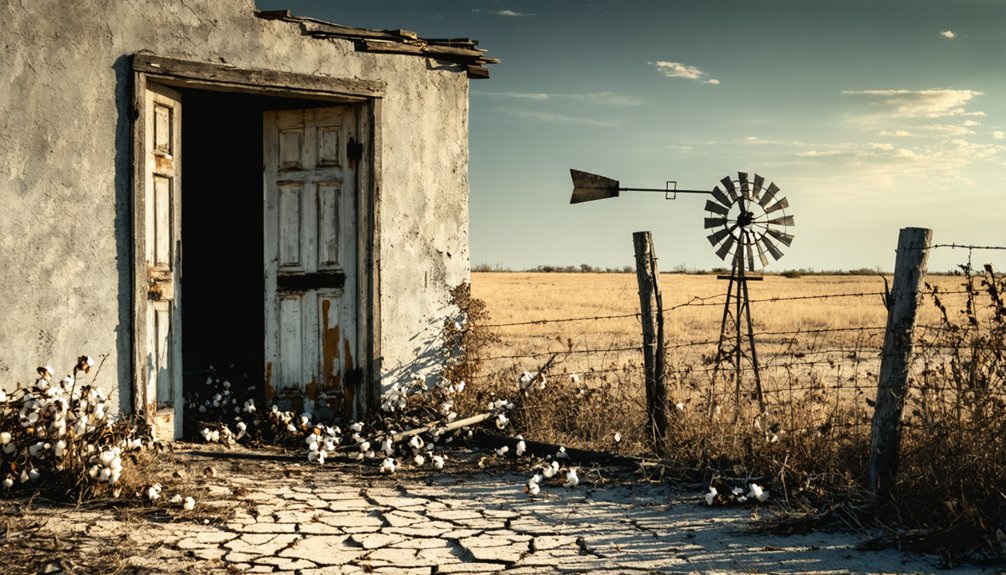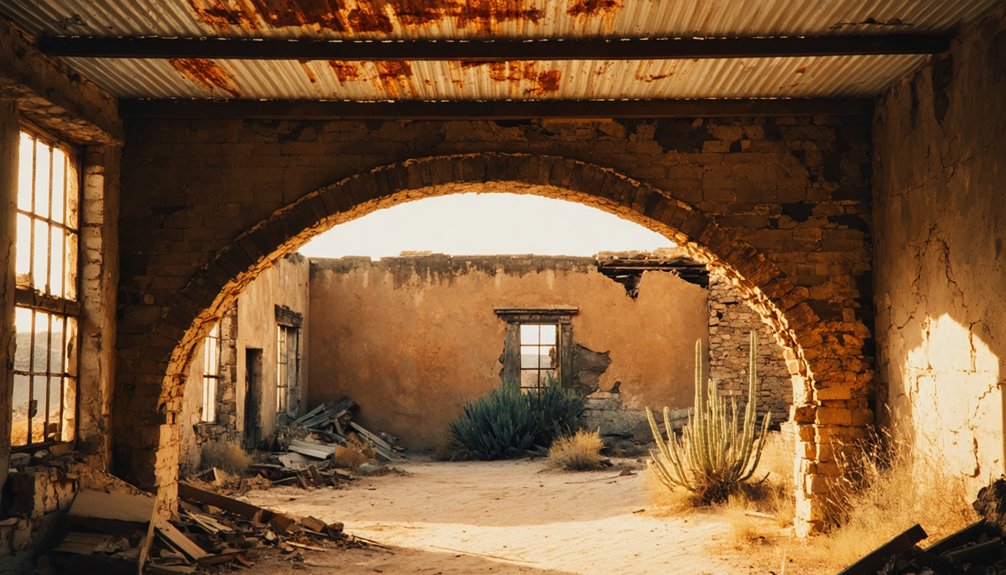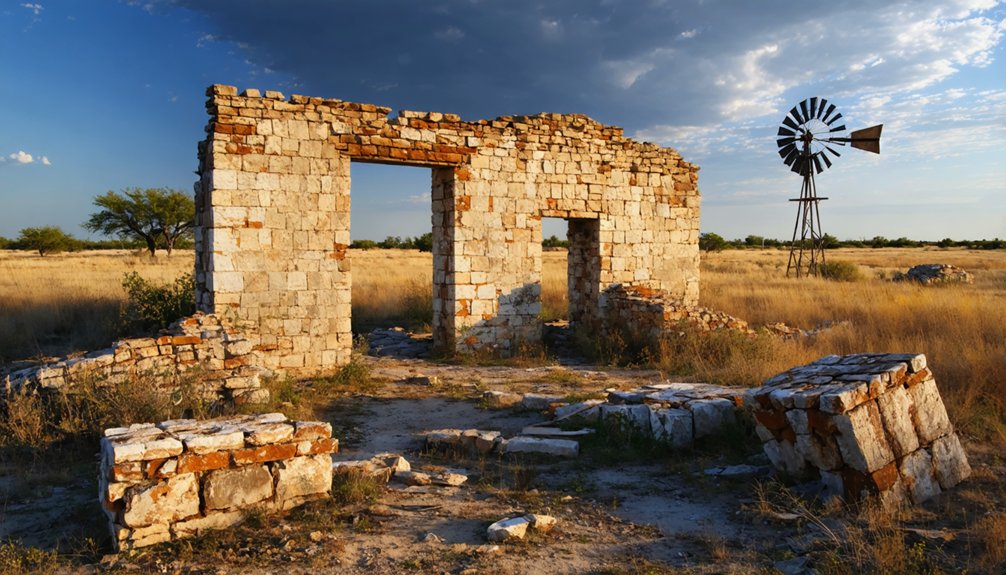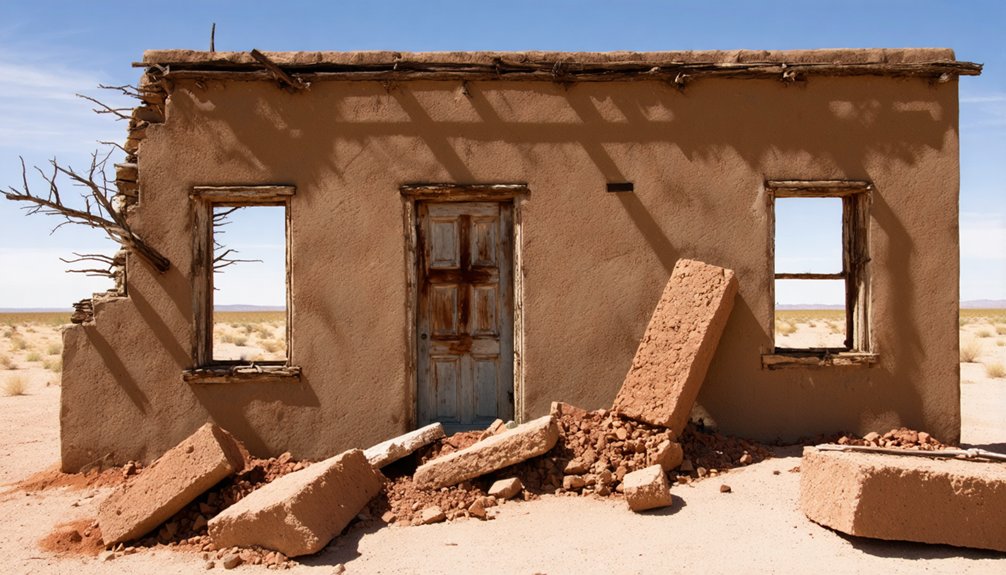You’ll find Sam Fordyce’s remains along Texas’s Rio Grande Valley, where it emerged in 1904 as the western terminus of the St. Louis, Brownsville & Mexico Railway. The town flourished with hotels, businesses, and oil discoveries, reaching its peak in the 1920s-1950s. Population declined sharply after the Great Depression, dwindling to 85 residents by the 1970s. Today, only crumbling foundations and overgrown structures hint at the fascinating story of this once-thriving railroad community.
Key Takeaways
- Sam Fordyce was established in 1904 as a railroad town and western terminus of the St. Louis, Brownsville & Mexico Railway.
- The town experienced prosperity through agriculture and oil discovery, reaching its peak between the 1920s and 1950s.
- Despite initial success with irrigation projects and oil fields, economic depression and water scarcity led to agricultural decline.
- Population dropped from 125 residents during the Great Depression to 85 by the 1970s, leading to near-total abandonment.
- Today, only crumbling building remains exist on private property, with no historical markers or archaeological studies conducted.
The Birth of a Railroad Town
In 1904, the St. Louis, Brownsville & Mexico Railway made a bold move into South Texas, establishing Sam Fordyce as its western terminus. You’ll find this strategic outpost emerged during a time of ambitious railroad expansion, when new rail lines were transforming Texas’s economic connectivity. Under leadership similar to Sam Fordyce, who had successfully guided the St. Louis Southwestern Railway to profitability, the new line sought growth opportunities.
The town quickly took shape in 1904-1905 as the endpoint of the Sam Fordyce branch line, featuring a bustling depot where you could witness the daily loading and unloading of freight and passengers. Initial optimism led to the construction of a prominent hotel and several businesses.
From this crucial hub, branch lines extended to other settlements like Mercedes, creating a web of commercial activity. A post office soon followed, cementing Sam Fordyce’s role as more than just a railway stop – it became a cornerstone of regional development and agricultural advancement in South Texas.
Sam Fordyce: The Man Behind the Name
Samuel Wesley Fordyce launched his railroad career as a station agent on the Central Ohio Railroad after serving as a cavalry officer in the Civil War.
You’ll find his influence grew substantially as he became a prominent railroad executive and financier in the American South, where he served on multiple boards and handled railroad receiverships during bankruptcies.
His connection to Texas emerged through his financial role in the St. Louis, Brownsville and Mexico Railway, which led to the naming of Sam Fordyce town in his honor around 1904. The settlement quickly established itself with a post office and other essential services for the growing community. Despite his namesake connection to the town, Samuel Fordyce Sr. did not participate in developing the settlement.
Railroad Pioneer Background
Railroad visionary Sam Fordyce launched his transformative career at age 20 as a station agent for the Central Ohio Railroad. His economic vision centered on developing the untapped potential of the southwestern United States through railroad innovation, believing the region would flourish with proper rail connectivity.
Over 16 years, you’ll find Fordyce’s influence expanding as he took on leadership roles across multiple railways. He served as vice president of the Texas and St. Louis Railway, guided the St. Louis, Arkansas & Texas Railway as both receiver and president, and led the Western Railway Company through critical reorganization. The completion of his Cotton Belt route in 1883 brought unprecedented growth to Arkansas towns like Pine Bluff and Texarkana. Throughout his career, his constructive genius helped finance or build over 24,000 miles of railway lines.
St. Louis Business Legacy
While establishing his railroad empire across the Southwest, Sam Fordyce built an equally impressive business legacy in Hot Springs, Arkansas, where he’d transform a modest village into a thriving health resort destination.
His Fordyce Investments included the grand Arlington Hotel, the opulent Eastman Hotel, and his crown jewel – the $220,000 Fordyce Bathhouse. He modernized the city’s utilities, including water, gas, and electric systems. After his successful tenure as Cotton Belt’s president, he relinquished control of the railroad in 1925.
Though the bathhouse wasn’t profitable, it showcased his commitment to luxury and innovation. The Missouri Pacific Lines would later acquire his railway interests in 1925.
Beyond Arkansas, Fordyce’s St. Louis Legacy grew through significant real estate acquisitions and business ventures. He leveraged partnerships with railroad magnates like Jay Gould, controlling over 24,000 miles of rail lines.
His strategic vision connected Hot Springs to major markets, cementing his influence across multiple industries in the American Southwest.
Early Settlement and Development
In 1905, a promising new settlement emerged at the western terminus of the St. Louis, Brownsville & Mexico Railway. Named after railroad executive Samuel W. Fordyce, who provided financial backing, the town quickly established essential railroad infrastructure to support its role as a transportation hub.
You’d have found the early community taking shape with key amenities, including a hotel, general store, and post office – which relocated from nearby Havana. The land developers platted new lots to accommodate the anticipated influx of settlers.
The town’s strategic location in Hidalgo County’s Rio Grande Valley positioned it to serve both agricultural and oil interests in the region. Railroad officials envisioned Sam Fordyce as a pivotal center for irrigation projects and farming development, investing in facilities and town layouts designed to attract settlers and support rail workers. The area would later become home to the rich oil reserves that transformed the regional economy.
Life Along the Tracks
Life along the St. Louis, Brownsville and Mexico Railway transformed Sam Fordyce into a bustling railroad community. The depot served as the heart of daily activities, where you’d find townspeople gathering to exchange news and greet travelers passing through.
Local businesses, from supply stores to boarding houses, sprung up to serve the steady stream of railroad workers and passengers. You’d notice how the town’s rhythm matched the railway schedules, with commerce and social life pulsing to the arrival and departure of trains.
The transient workforce of railroad employees and their families created a dynamic social fabric, while merchants and agricultural laborers established more permanent roots. The single-track line connected you to major hubs like Harlingen and Brownsville, though you’d have to work around the limitations of available rolling stock and sidings.
Agricultural Dreams and Reality

As you explore Sam Fordyce’s agricultural ambitions, you’ll find a story of high hopes built on irrigation schemes that promised to transform arid ranchland into fertile farms during the early 1900s.
The town’s backers envisioned it becoming a thriving agricultural hub, capitalizing on the Lower Rio Grande Valley’s mild climate and long growing season for multiple annual crops.
Yet by the 1930s, you’d see these dreams withering amid economic depression, devastating freezes, and water scarcity that drove farmers away and left irrigation systems to decay.
Irrigation Dreams and Failures
While the Lower Rio Grande Valley pioneered large-scale irrigation in Texas, Sam Fordyce’s ambitious agricultural vision stood out for establishing the region’s largest privately owned irrigation system.
You’d have seen an impressive 500-foot-wide swath cleared from the Rio Grande to the railroad, stretching 7 miles with 300 mule teams working the excavation.
The irrigation challenges were immense, but the promise of agricultural transformation drove massive investment. You could’ve witnessed multiple crop cycles yearly as the system turned semi-arid land into fertile fields for citrus and vegetables.
But by the 1920s, the dream began unraveling. The Great Depression hit hard, dramatically reducing irrigated acreage. Environmental hazards, including droughts, unexpected freezes, and floods, further disrupted farming operations despite the elaborate canal infrastructure.
Farms Left Behind
The agricultural dream of Sam Fordyce began with grand visions of fertile farmland stretching across the Rio Grande Valley.
You’d have seen extensive plots carefully laid out alongside the railway terminus, with ambitious plans for one of the largest private canal networks in Texas.
But today, you’ll find only abandoned fields where hopeful settlers once cleared land and dug irrigation channels.
The forgotten farms tell a story of broken dreams, crushed by devastating land title disputes and legal complications.
These issues prevented the irrigation systems from reaching their full potential, while economic realities fell far short of expectations.
As farming attempts faltered, settlers and investors abandoned their agricultural ambitions, leaving behind empty fields.
The ghost town‘s silent landscape serves as a reflection of the harsh gap between agricultural aspirations and the unforgiving realities of early 20th-century Texas farming.
The Golden Years
Sam Fordyce’s golden era began in 1904 when the St. Louis, Brownsville & Mexico Railway established its western terminus there.
You’d have witnessed rapid growth as the railroad brought jobs, commerce, and new residents to this strategic location near Fort Ringgold. The town’s economic prosperity soared even higher with the discovery of the Sam Fordyce oil field, transforming the community into a bustling energy hub.
As community milestones accumulated, you’d have seen schools, churches, and stores spring up alongside the expanding rail yards and oil facilities.
The town attracted diverse workers from Missouri and Dallas, creating a vibrant mix of cultures. From the 1920s through the 1950s, Sam Fordyce thrived with hotels, general stores, and social venues serving both locals and travelers during the peak of its railroad and oil-driven prosperity.
Signs of Decline

Despite its earlier prosperity, signs of decline emerged in Sam Fordyce during the Great Depression when the population stabilized at around 125 residents. The downward population trends continued relentlessly, dropping to 85 by the 1970s before the town faced near-total abandonment.
From a thriving frontier town to a fading memory, Sam Fordyce’s population dwindled steadily until hardly anyone remained.
Economic impacts hit hard as the military fort’s closure eliminated jobs, while the shuttering of the post office and local businesses erased essential services.
- Infrastructure crumbled as buildings were abandoned and fell into disrepair
- Transportation routes bypassed the town, increasing its isolation
- Community institutions vanished, destroying social connections
- Geographic remoteness discouraged new investment and settlement
You can still see scattered ruins west of La Joya today, silent witnesses to the town’s transformation from a bustling community to another Texas ghost town.
A Town Forgotten
Once a promising railroad terminus established in 1905, Sam Fordyce’s story now exists primarily through scattered ruins and fading memories.
You’ll find little evidence of the ambitious plans that once shaped this South Texas settlement, where Samuel W. Fordyce’s namesake town was meant to flourish as an agricultural and transportation hub.
The ghostly echoes of its brief existence remind you of how quickly a town can vanish.
Despite having essential structures – a hotel, post office, and store – Sam Fordyce never achieved significant population growth.
The town memories that remain tell of a community that relied heavily on the railroad’s presence, with most residents being transient workers.
What Remains Today

Today, scattered remnants of crumbling buildings stand as silent witnesses to Sam Fordyce’s brief existence. If you’re hoping to explore these ruins, you’ll find a challenging landscape where nature has steadily reclaimed the town site.
The military fort’s structural remains and deteriorating foundations of the post office and hotel are still visible, though they face ongoing preservation challenges without any official protection.
- No maintained roads or infrastructure support ruins exploration
- Limited public access as the site sits on private property
- Wild vegetation increasingly obscures the remaining structures
- Absence of historical markers or formal archaeological studies
The semi-arid South Texas environment continues to take its toll on these unprotected remnants, while local interest relies mainly on informal documentation through photographs and storytelling to keep the town’s memory alive.
Frequently Asked Questions
Were There Any Major Crimes or Notable Incidents in Sam Fordyce?
You won’t find any documented major crimes or notable incidents in historical records. Research shows no significant crime history during the town’s existence from 1905 through its decline into abandonment.
What Happened to the Residents When They Left Sam Fordyce?
You’ll find most residents relocated to nearby towns, seeking jobs in agriculture and oil sectors. Their relocation stories reveal they settled in Hidalgo County communities, while others chose growing railroad hubs.
Did Any Famous People Ever Visit or Pass Through Sam Fordyce?
Like a lonely desert outpost, Sam Fordyce didn’t attract famous visitors during its heyday. Historical records don’t show any notable personalities passing through, except railroad workers managing the terminus operations.
Were There Any Natural Disasters That Affected Sam Fordyce?
You won’t find any documented flood damage or drought impact specifically affecting Sam Fordyce in historical records. While Texas faced many natural disasters, there’s no evidence of any directly impacting this settlement.
Did Sam Fordyce Have Any Connection to Mexico During Prohibition?
While you’ll find connections through the St. Louis, Brownsville & Mexico Railway for legal trade, there’s no historical evidence linking Sam Fordyce to Prohibition smuggling or illegal Texas-Mexico relations during 1920-1933.
References
- https://discovertexasoutdoors.com/places/sam-fordyce-texas-a-ghost-town-with-roots-in-railroads-and-oil/
- https://www.ghosttowns.com/states/tx/samfordyce.html
- https://en.wikipedia.org/wiki/List_of_ghost_towns_in_Texas
- https://www.tshaonline.org/handbook/entries/sam-fordyce-tx
- https://www.newspapers.com/article/26393110/history_of_sam_fordyce_oil_fieldhidalgo/
- https://www.texasescapes.com/TOWNS/Texas-Ghost-Towns-8-South-Texas.htm
- https://www.texasescapes.com/SouthTexasTowns/Sam-Fordyce-Texas.htm
- http://txrrhistory.com/towers/200/200.htm
- https://en.wikipedia.org/wiki/Samuel_W._Fordyce
- https://www.texasalmanac.com/places/capisallo



